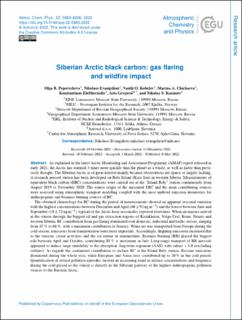| dc.contributor.author | Popovicheva, Olga | |
| dc.contributor.author | Evangeliou, Nikolaos | |
| dc.contributor.author | Kobelev, Vasily O. | |
| dc.contributor.author | Chichaeva, M. A. | |
| dc.contributor.author | Eleftheriadis, Konstantinos | |
| dc.contributor.author | Gregorič, Asta | |
| dc.contributor.author | Kasimov, Nikolay | |
| dc.date.accessioned | 2022-05-30T10:38:52Z | |
| dc.date.available | 2022-05-30T10:38:52Z | |
| dc.date.created | 2022-05-19T12:45:50Z | |
| dc.date.issued | 2022 | |
| dc.identifier.citation | Atmospheric Chemistry and Physics (ACP). 2022, 22, 5983-6000. | en_US |
| dc.identifier.issn | 1680-7316 | |
| dc.identifier.uri | https://hdl.handle.net/11250/2996735 | |
| dc.description.abstract | As explained in the latest Arctic Monitoring and Assessment Programme (AMAP) report released in early 2021, the Arctic has warmed 3 times more quickly than the planet as a whole, as well as faster than previously thought. The Siberian Arctic is of great interest mainly because observations are sparse or largely lacking. A research aerosol station has been developed on Bely Island (Kara Sea) in western Siberia. Measurements of equivalent black carbon (EBC) concentrations were carried out at the “Island Bely” station continuously from August 2019 to November 2020. The source origin of the measured EBC and the main contributing sources were assessed using atmospheric transport modeling coupled with the most updated emission inventories for anthropogenic and biomass burning sources of BC. The obtained climatology for BC during the period of measurements showed an apparent seasonal variation with the highest concentrations between December and April (60 ± 92 ng m−3) and the lowest between June and September (18 ± 72 ng m−3), typical of the Arctic haze seasonality reported elsewhere. When air masses arrived at the station through the biggest oil and gas extraction regions of Kazakhstan, Volga-Ural, Komi, Nenets and western Siberia, BC contribution from gas flaring dominated over domestic, industrial and traffic sectors, ranging from 47 % to 68 %, with a maximum contribution in January. When air was transported from Europe during the cold season, emissions from transportation were more important. Accordingly, shipping emissions increased due to the touristic cruise activities and the ice retreat in summertime. Biomass burning (BB) played the biggest role between April and October, contributing 81 % at maximum in July. Long-range transport of BB aerosols appeared to induce large variability to the absorption Ångström exponent (AAE) with values > 1.0 (excluding outliers). As regards the continental contribution to surface BC at the Island Bely station, Russian emissions dominated during the whole year, while European and Asian ones contributed up to 20 % in the cold period. Quantification of several pollution episodes showed an increasing trend in surface concentrations and frequency during the cold period as the station is directly in the Siberian gateway of the highest anthropogenic pollution sources to the Russian Arctic. | en_US |
| dc.description.abstract | Siberian Arctic black carbon: gas flaring and wildfire impact | en_US |
| dc.language.iso | eng | en_US |
| dc.rights | Navngivelse 4.0 Internasjonal | * |
| dc.rights.uri | http://creativecommons.org/licenses/by/4.0/deed.no | * |
| dc.title | Siberian Arctic black carbon: gas flaring and wildfire impact | en_US |
| dc.title.alternative | Siberian Arctic black carbon: gas flaring and wildfire impact | en_US |
| dc.type | Peer reviewed | en_US |
| dc.type | Journal article | en_US |
| dc.description.version | publishedVersion | en_US |
| dc.rights.holder | © Author(s) 2022. | en_US |
| dc.source.pagenumber | 5983-6000 | en_US |
| dc.source.volume | 22 | en_US |
| dc.source.journal | Atmospheric Chemistry and Physics (ACP) | en_US |
| dc.identifier.doi | 10.5194/acp-22-5983-2022 | |
| dc.identifier.cristin | 2025607 | |
| dc.relation.project | Norges forskningsråd: 275407 | en_US |
| dc.relation.project | EC/H2020/101008004 | en_US |
| dc.relation.project | EC/H2020/871115 | en_US |
| cristin.ispublished | true | |
| cristin.fulltext | original | |
| cristin.qualitycode | 2 | |

